ASRock DeskMeet B660 Review: An Affordable NUC Extreme?
by Ganesh T S on January 23, 2023 8:30 AM EST- Posted in
- Systems
- ASRock
- SilverStone
- SFF
- Mushkin
- Alder Lake
- B660
- DeskMeet
- Raptor Lake
GPU Performance: Synthetic Benchmarks
Discrete GPUs are included in systems for a variety of purposes. The most common scenario is one in which the end user requires better gaming performance than what an integrated GPU can provide. The other reason could be workstation performance. Yet another possibility is a system equipped with a CPU that doesn't support any graphics output. The AMD Radeon RX 6400 is a good fit in the third scenario. It operates well below the 75W limit imposed by the PCIe slot's power delivery mechanism. It provides two display outputs capable of driving 8K displays, if required. As per marketing claims, it provides good enough 1080p gaming performance. GPU performance evaluation typically involved gaming workloads, and for select PCs, GPU compute. Prior to that, a look at the capabilities of the GPU installed in the DeskMeet B660 is warranted.
The AMD Radeon RX 6400 is a Navi 24 GPU built in the TSMC 6nm process. The ASRock Challenger ITX version configures it with a 4-lane PCIe 4.0 interface and 4GB of GDDR6 VRAM. The card is very weak in terms of multimedia capabilities, with a limited set of codecs support for hardware decoding and no VCE (encoding) support. Overall, it is a decent card to add a display output to an otherwise bare system. However, we decided to evaluate the gaming performance also, in order to gauge ASRock's claims of it being suitable for 1080p gaming. Additional comparison numbers with integrated GPUs can be obtained in the graphs from our ASRock NUC BOX-1260P and ASRock 4x4 BOX-5800U review here.
GFXBench
The DirectX 12-based GFXBench tests from Kishonti are cross-platform, and available all the way down to smartphones. As such, they are not very taxing for discrete GPUs and modern integrated GPUs. We processed the offscreen versions of the 'Aztec Ruins' benchmark.
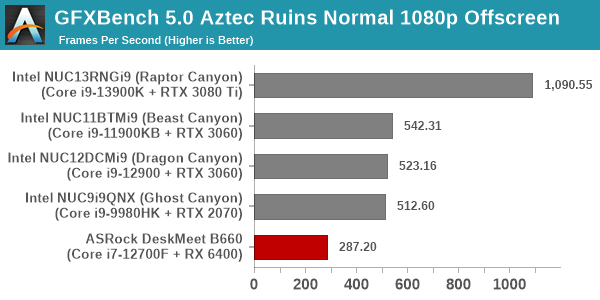
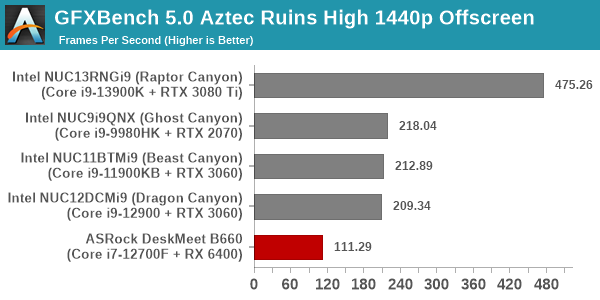
The raw numbers are very good, but are well behind the other systems in the mix. Comparison with the best integrated GPUs in UCFF systems from Intel and AMD show these numbers to be better by a factor of more than 2.5 - commensurate with the delta in the power allocation for the GPU.
UL 3DMark
Four different workload sets were processed in 3DMark - Fire Strike, Time Spy, Night Raid, and Wild Life.
3DMark Fire Strike
The Fire Strike benchmark has three workloads. The base version is meant for high-performance gaming PCs. It uses DirectX 11 (feature level 11) to render frames at 1920 x 1080. The Extreme version targets 1440p gaming requirements, while the Ultra version targets 4K gaming system, and renders at 3840 x 2160. The graph below presents the overall score for the Fire Strike Extreme and Fire Strike Ultra benchmark across all the systems that are being compared.
| UL 3DMark - Fire Strike Workloads | |||
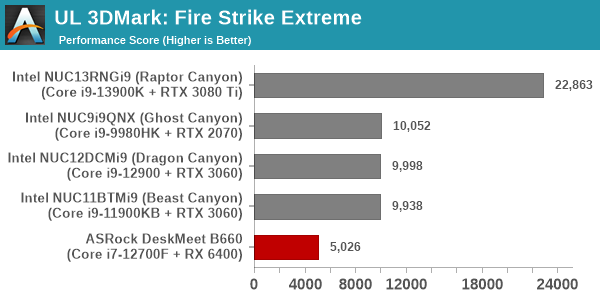
3DMark Time Spy
The Time Spy workload has two levels with different complexities. Both use DirectX 12 (feature level 11). However, the plain version targets high-performance gaming PCs with a 2560 x 1440 render resolution, while the Extreme version renders at 3840 x 2160 resolution. The graphs below present both numbers for all the systems that are being compared in this review.
| UL 3DMark - Time Spy Workloads | |||
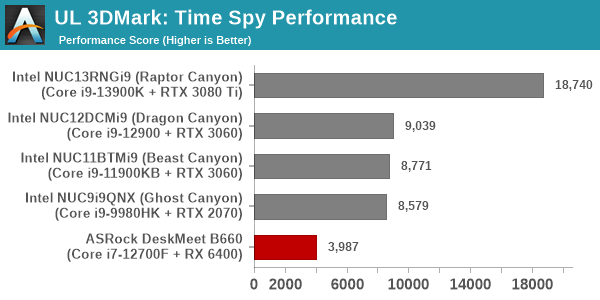
3DMark Wild Life
The Wild Life workload was initially introduced as a cross-platform GPU benchmark in 2020. It renders at a 2560 x 1440 resolution using Vulkan 1.1 APIs on Windows. It is a relatively short-running test, reflective of mobile GPU usage. In mid-2021, UL released the Wild Life Extreme workload that was a more demanding version that renders at 3840 x 2160 and runs for a much longer duration reflective of typical desktop gaming usage.
| UL 3DMark - Wild Life Workloads | |||
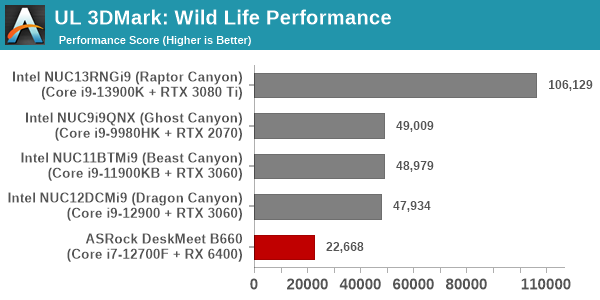
All of the above workloads are for systems intended for gaming at 1440p or higher resolutions, but we do get an idea of the relative performance numbers (which are as per expectations).
3DMark Night Raid
The Night Raid workload is a DirectX 12 benchmark test. It is less demanding than Time Spy, and is optimized for integrated graphics. The graph below presents the overall score in this workload for different system configurations.

All the scores in the above benchmarks are significantly better than the ones that the best integrated GPU can provide (by a factor of around 2.5x consistently). The RX 6400 is indeed a good upgrade to an integrated GPU for 3D performance, and a good low-power display-output enabling card for iGPU-less systems like our DeskMeet B660 configuration.
3DMark Port Royal
UL introduced the Port Royal ray-tracing benchmark as a DLC for 3DMark in early 2019. The scores serve as an indicator of how the system handles ray-tracing effects in real-time.
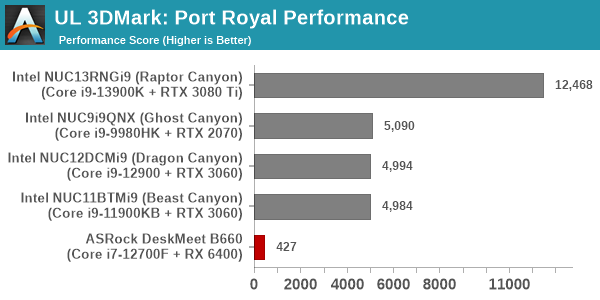
Despite being a low-end card, the RX 6400 does include hardware ray-tracing and completed the Port Royal benchmark successfully. The score, though, is nothing to write home about.


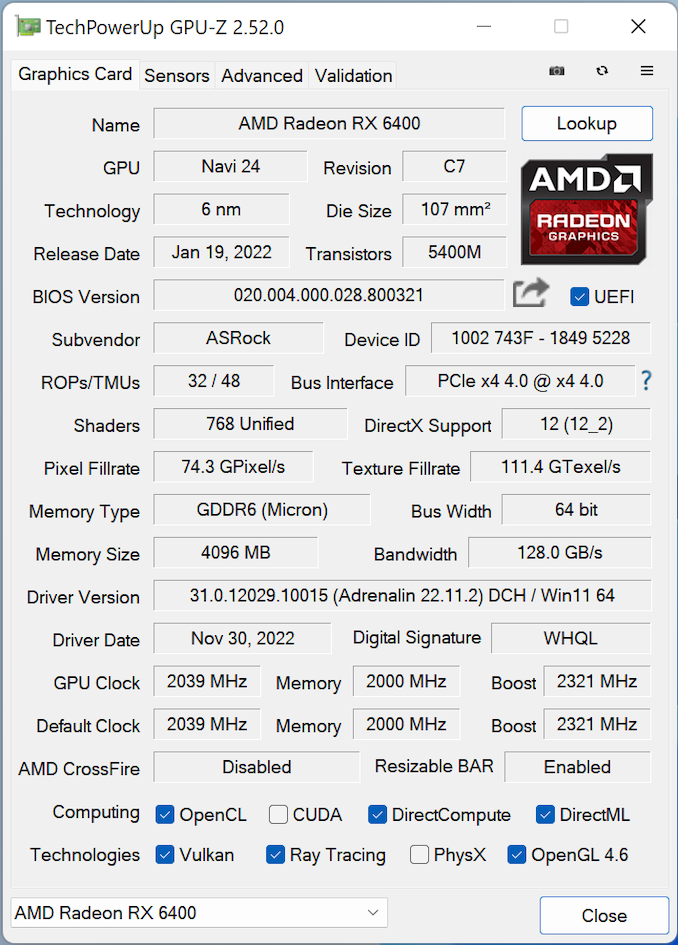








27 Comments
View All Comments
1_rick - Monday, January 23, 2023 - link
No pictures of the system with the GPU installed?megadirk - Monday, January 23, 2023 - link
I found one on their newegg listing under user review pictures. https://c1.neweggimages.com/itemreivewimages/revie...1_rick - Monday, January 23, 2023 - link
Thanks! I searched the site to find the rest of the images--the one showing the back panel doesn't have an add-in card installed at all. It looks like the card in your image is probably something like a dual NIC based on the shape of the metal boxes connected to the card backplane. I certainly hope that's not a GPU considering if it is whoever put that together would've had to take off the heat sink and hope a regular 120MM fan would cool it!ganeshts - Monday, January 23, 2023 - link
I will upload some more images in a gallery in the 'Assembling the System' sub-section later tonight. Yes, that image is not one of a GPU. If a GPU is installed, it becomes impossible to install the extra fan in the system. Even a single-slot GPU's cooling solution would interfere with the fan placement.With a single-slot GPU, two 2.5" drives can be installed in the place where the fan is seen. In the vertical orientation, the fan appears on top of the case.
With a dual-slot GPU, there is very little gap between the top of the case and the GPU's cooling solution. The GPU fan exhausts hot air directly out through the perforations on the top of the chassis.
ganeshts - Tuesday, January 24, 2023 - link
A gallery with pictures from the assembly process has now been added in the relevant section.The GPU is in the picture starting from https://www.anandtech.com/Gallery/Album/8223#31
1_rick - Wednesday, January 25, 2023 - link
Thanks, Ganesh.ballsystemlord - Monday, January 23, 2023 - link
@Ganesh Nice to see a Navi product being benchmarked. It's been a long time.RaiderJ - Monday, January 23, 2023 - link
I'm surprised they didn't go with a smaller ITX PSU. Seems like a simple way to reduce the size with minimal impact to cost/noise/heat.meacupla - Monday, January 23, 2023 - link
yeah, the back panel shows a mounting point for SFX PSUs. Asrock must have used an ATX for cost reasons.thomasjkenney - Monday, January 23, 2023 - link
Thanks, this is a good read."Unfortunately, the documentation is not clear from the documentation..."
You don't say? :)